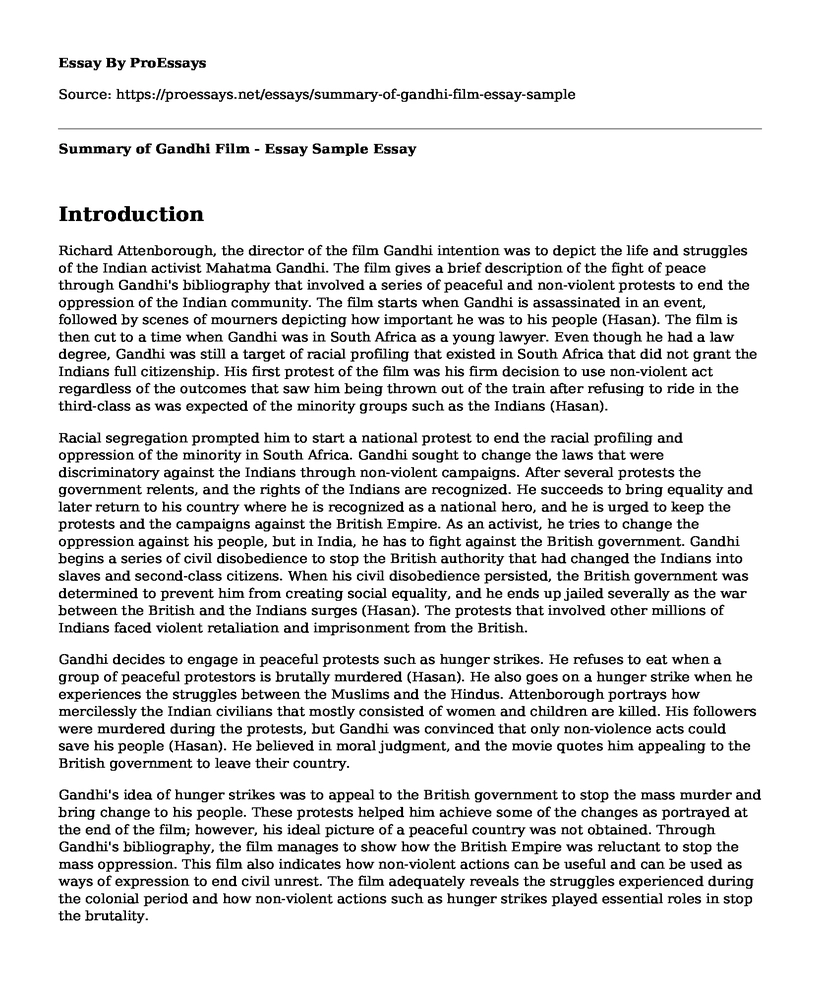Introduction
Richard Attenborough, the director of the film Gandhi intention was to depict the life and struggles of the Indian activist Mahatma Gandhi. The film gives a brief description of the fight of peace through Gandhi's bibliography that involved a series of peaceful and non-violent protests to end the oppression of the Indian community. The film starts when Gandhi is assassinated in an event, followed by scenes of mourners depicting how important he was to his people (Hasan). The film is then cut to a time when Gandhi was in South Africa as a young lawyer. Even though he had a law degree, Gandhi was still a target of racial profiling that existed in South Africa that did not grant the Indians full citizenship. His first protest of the film was his firm decision to use non-violent act regardless of the outcomes that saw him being thrown out of the train after refusing to ride in the third-class as was expected of the minority groups such as the Indians (Hasan).
Racial segregation prompted him to start a national protest to end the racial profiling and oppression of the minority in South Africa. Gandhi sought to change the laws that were discriminatory against the Indians through non-violent campaigns. After several protests the government relents, and the rights of the Indians are recognized. He succeeds to bring equality and later return to his country where he is recognized as a national hero, and he is urged to keep the protests and the campaigns against the British Empire. As an activist, he tries to change the oppression against his people, but in India, he has to fight against the British government. Gandhi begins a series of civil disobedience to stop the British authority that had changed the Indians into slaves and second-class citizens. When his civil disobedience persisted, the British government was determined to prevent him from creating social equality, and he ends up jailed severally as the war between the British and the Indians surges (Hasan). The protests that involved other millions of Indians faced violent retaliation and imprisonment from the British.
Gandhi decides to engage in peaceful protests such as hunger strikes. He refuses to eat when a group of peaceful protestors is brutally murdered (Hasan). He also goes on a hunger strike when he experiences the struggles between the Muslims and the Hindus. Attenborough portrays how mercilessly the Indian civilians that mostly consisted of women and children are killed. His followers were murdered during the protests, but Gandhi was convinced that only non-violence acts could save his people (Hasan). He believed in moral judgment, and the movie quotes him appealing to the British government to leave their country.
Gandhi's idea of hunger strikes was to appeal to the British government to stop the mass murder and bring change to his people. These protests helped him achieve some of the changes as portrayed at the end of the film; however, his ideal picture of a peaceful country was not obtained. Through Gandhi's bibliography, the film manages to show how the British Empire was reluctant to stop the mass oppression. This film also indicates how non-violent actions can be useful and can be used as ways of expression to end civil unrest. The film adequately reveals the struggles experienced during the colonial period and how non-violent actions such as hunger strikes played essential roles in stop the brutality.
Conclusion
In conclusion, the film effectively addresses the war between the Muslims and the Hindus, and the great partition of Pakistan and India that devastated Gandhi. Despite fighting for peace between nations, his actions were not welcomed by dissents that prompted one of them to assassinate him. This film illustrates the need to engage in peaceful and thoughtful reactions to stop the wars experienced today without using violent retaliation tactics.
Works Cited
Hasan, Ansari Noorul. Gandhi 1982 Full Film Gave Freedom To World By Islam. Vimeo, 2017, https://vimeo.com/184381280.
Cite this page
Summary of Gandhi Film - Essay Sample. (2022, Dec 18). Retrieved from https://proessays.net/essays/summary-of-gandhi-film-essay-sample
If you are the original author of this essay and no longer wish to have it published on the ProEssays website, please click below to request its removal:
- Film Analysis Essay on Hunger Games: Mocking Jay
- Gorgias' "Encomium of Helen" Speech and How Powerful Speech Can Bean
- This is How the Space Race Changed the Great Power Rivalry Forever Essay
- Analysis of Sequence of the Downfall Film Essay Example
- Pax Britannica and the Pax Americana Eras Essay Example
- Essay Example on Egypt Uprising Aftermath: Protests Over Gov't Failure to Protect Minorities
- Free Essay Sample on Body Positivity







